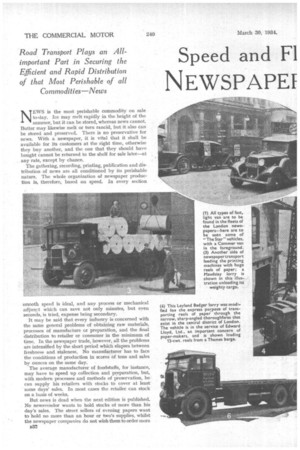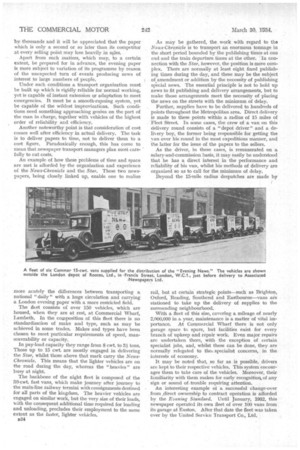Speed and Fl Lbility Vital in
Page 38

Page 39

Page 40

If you've noticed an error in this article please click here to report it so we can fix it.
N EWSPAPEI
TRANSPORT
Road Transport Plays an Allimportant Part in Securing the Efficient and Rapid Distribution of that Most Perishable of all Commodities—News Reliability and Elasticity of Transport Arrangements are Essential to Meet Urgent Changes that May Have to be Made in the Publishing Programmes
NEWS is the most perishable commodity on sale to-day. Ice may melt rapidly in the height of the summer, but it can be stored, whereas news cannot. Butter may likewise melt or turn rancid, but it also can be stored and preserved. There is no preservative for news. With a newspaper, it is vital that it shall be available for its customers at the right time, otherwise they buy another, and the one that they should have bought cannot be returned to the shelf for sale later—at any rate, except by chance.
The gathering, recording, printing, publication and distribution of news are all conditioned by its perishable nature. The whole organization of newspaper production is, therefore, based on speed. In every section smooth speed is ideal, and any process or mechanical adjunct which can save not only minutes, but even seconds, is tried, expense being secondary.
It may be said that every industry is concerned with the same general problems of obtaining raw materials, processes of manufacture cr preparation, and the final distribution to retailer or consumer in the minimum of time. In the newspaper trade, however, all the problems are intensified by the short period which elapses between freshness and staleness. No manufacturer has to face the conditions of production in scores of tons and sales by ounces on the same day.
The average manufacturer of foodstuffs, for instance, may have to speed up collection and preparation, but, with modern processes and methods of preservation, he can supply his retailers with stocks to cover at least some days' sales. In most cases the retailer can stock on a basis of weeks.
But news is dead when the next edition is published. No newsvendor wants to hold stocks of more than his day's sales. The street sellers of evening papers want to hold no more than an hour or two's supplies, whilst the newspaper companies do not wish them to order more B32 than that quantity. With every process and department of production being primarily concerned with speed, it is obvious that great attention has been paid to rapidity and reliability of delivery. Here road transport is preeminent in all but the longest runs.
There are three classes of newspaper—morning, evening and weekly—each with a different aspect of the same essential problem. The daily paper is distributed over a wide area, and its editions are printed at times to allow of delivery well before breakfast. The first edition is designed for the farthest point of its area, and succeeding editions for districts nearer the centre. Its time-tables are compiled to seconds to meet the requirements of delivery, and only one thing is allowed to interfere with scheduled arrangements. That one thing is news itself.
If a sufficiently important event occurs, the time-table may be discarded and special editions rushed out. The effect of this disruption must be felt in every department, but in none more so than that concerned with transport. It may mean the conjuring up of additional fast vehicles in the middle of the night to take the place of trains which have departed.
The weekly or Sunday paper is, in effect, a " daily " published once aareek, and its problems are largely those of the "daily." it is probably the evening paper which is most troublesome, not so much because of the volume and weight of material to be carried, but because of the number of its editions and the fact that its effective life is even shorter than that of its morning contemporary.
The production programme of the evening paper is based on the times of race meetings and other sporting events. A big proportion of importance also attaches to pending results of prominent court cases and notable affairs in Parliamentary, Stock Exchange and other spheres. The man wishing to learn the result of the Grand National does not trouble greatly which paper he buys. He purchases the first available. Multiply this by thousands and it will be appreciated that the paper which is only a second or so later than its competitor at every selling point may lose heavily in sales.
Apart from such matters, which may, to a certain extent, be prepared for in advance, the evening paper is more subject to variation of its programme by reason of the unexpected turn of events producing news of interest to large numbers of people.
Under such conditions a transport organization must be built up which is rigidly reliable for normal working, yet is capable of instant extension or adaptation to meet emergencies. It must be a smooth-running system, yet be capable of the wildest improvizations. Such conditions need something approaching genius on the part of the man in charge, together with vehicles of the highest order of reliability and efficiency.
Another noteworthy point is that consideration of cost comes well after efficiency in actual delivery. The task is to deliver papers to time, not to deliver them to a cost figure. Paradoxically enough, this has come to mean that newspaper transport managers plan most carefully to cut costs.
An exampie of how these problems of time and space are met is afforded by the organization and experience of the News-Chronicle and the Star. These two newspapers, being closely linked up, enable one to realize
more acutely the differences between transporting a national " daily " with a huge circulation and carrying a London evening paper with a more restricted field.
The Beet consists of over 150 vehicles, which are housed, when they are at rest, at Commercial Wharf, Lambeth. In the composition of this fleet there is no standardization of make and type, such as may be achieved in some trades. Makes and types have been chosen to meet particular requirements of speed, manmuvrability or capacity.
In pay-load capacity they range from 8 cwt. to 3i tons. Those up to 15 cwt. are mostly engaged in delivering the Star, whilst those above that mark carry the NewsChronicle. This means that the lighter vehicles are on the road during the day, whereas the "heavies" are busy at night.
The backbone of the night fleet is composed of the 80-cwt. fast vans, which make journey after journey to the main-line railway termini with consignments destined for all parts of the kingdom. The heavier vehicles are engaged on similar work, but the very size of their loads, with the consequent additional time required for loading and unloading, precludes their employment to the same extent as the faster, lighter vehicles. As may be gathered, the work with regard to the News-Chronicle is to transport an enormous tonnage in the short period bounded by the publishing times at one end and the train departure times at the other. In connection with the Star, however, the position is more complex. There are normally at least eight fixed publishing times during the day, and these may be the subject of amendment or addition by the necessity of publishing special news. The essential principle is not to hold up news to fit publishing and delivery arrangements, but to make those arrangements meet the necessity of placing the news on the streets with the minimum of delay.
Further, supplies have to be delivered to hundreds of points throughout the Metropolitan area. Direct delivery is made to these points within a radius of 15 miles of Fleet Street. In some cases, the crew of a van on this delivery round consists of a "depot driver" and a delixery boy, the former being responsible for getting the van over his round in the most expeditious manner, and the latter for the issue of the papers to the sellers.
As the driver, in these cases, is remunerated on a salary-and-commission basis, it may easily be understood that he has a direct interest in the performance and reliability of his van, whilst his methods of delivery are organized so as to call for the minimum of delay.
Beyond the 15-mile radius despatches are made by rail, but at certain strategic points—such as Brighton, Oxford, Reading, Southend and Eastbourne—vans are stationed to take up the delivery of supplies to the surrounding neighbourhood.
With a fleet of this size, covering a mileage of nearly 2,000,000 in a year, maintenance is a matter of vital importance. At Commercial Wharf there is not only garage space to spare, but facilities exist for every branch of upkeep and repair work. Even major repairs are undertaken there, with the exception of certain specialist jobs, and, whilst these can be done, they are normally relegated to the., specialist concerns, in the interests of economy.
It may be noted that, so far as is possible, drivers are kept to their respective vehicles. This system encourages them to take care of the vehicles. Moreover, their familiarity with them makes for early recognition. of any sign or sound of ,trouble requiring attention.
An interesting example of a successful change-over from direct ownership to contract operation is afforded by the Evening Standard. Until January, 1932, this newspaper operated its own fleet of over 100 vans from its garage at Easton. After that date the fleet was taken over by the United Service Transport Co., Ltd.












































































